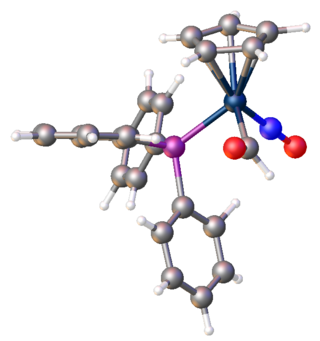Related Research Articles
Cyclopentadiene is an organic compound with the formula C5H6. It is often abbreviated CpH because the cyclopentadienyl anion is abbreviated Cp−.
Oxidative addition and reductive elimination are two important and related classes of reactions in organometallic chemistry. Oxidative addition is a process that increases both the oxidation state and coordination number of a metal centre. Oxidative addition is often a step in catalytic cycles, in conjunction with its reverse reaction, reductive elimination.

Metal carbonyls are coordination complexes of transition metals with carbon monoxide ligands. Metal carbonyls are useful in organic synthesis and as catalysts or catalyst precursors in homogeneous catalysis, such as hydroformylation and Reppe chemistry. In the Mond process, nickel tetracarbonyl is used to produce pure nickel. In organometallic chemistry, metal carbonyls serve as precursors for the preparation of other organometallic complexes.

Malcolm Leslie Hodder Green was Professor of Inorganic Chemistry at the University of Oxford. He made many contributions to organometallic chemistry.

Jean-Marie Basset is a French chemist, and is currently the director of KAUST catalysis research center.
A hydrogenase mimic or bio-mimetic is an enzyme mimic of hydrogenases.
In organometallic chemistry, a migratory insertion is a type of reaction wherein two ligands on a metal complex combine. It is a subset of reactions that very closely resembles the insertion reactions, and both are differentiated by the mechanism that leads to the resulting stereochemistry of the products. However, often the two are used interchangeably because the mechanism is sometimes unknown. Therefore, migratory insertion reactions or insertion reactions, for short, are defined not by the mechanism but by the overall regiochemistry wherein one chemical entity interposes itself into an existing bond of typically a second chemical entity e.g.:
Transition metal hydrides are chemical compounds containing a transition metal bonded to hydrogen. Most transition metals form hydride complexes and some are significant in various catalytic and synthetic reactions. The term "hydride" is used loosely: some of them are acidic (e.g., H2Fe(CO)4), whereas some others are hydridic, having H−-like character (e.g., ZnH2).
James P. Collman is an American chemist who is the George A. and Hilda M. Daubert Professor of Chemistry, Emeritus at Stanford University. Collman's research focused on organometallic bioinorganic chemistry. Collman is a member of the National Academy of Sciences.
In organic chemistry, a cross-coupling reaction is a reaction where two different fragments are joined. Cross-couplings are a subset of the more general coupling reactions. Often cross-coupling reactions require metal catalysts. One important reaction type is this:

Organorhodium chemistry is the chemistry of organometallic compounds containing a rhodium-carbon chemical bond, and the study of rhodium and rhodium compounds as catalysts in organic reactions.

Cobalt tetracarbonyl hydride is an organometallic compound with the formula HCo(CO)4. It is a volatile, yellow liquid that forms a colorless vapor and has an intolerable odor. The compound readily decomposes upon melt and in absentia of high CO partial pressures forms Co2(CO)8. Despite operational challenges associated with its handling, the compound has received considerable attention for its ability to function as a catalyst in hydroformylation. In this respect, HCo(CO)4 and related derivatives have received significant academic interest for their ability to mediate a variety of carbonylation (introduction of CO into inorganic compounds) reactions.

Iron tetracarbonyl dihydride is the organometallic compound with the formula H2Fe(CO)4. This compound was the first transition metal hydride discovered. The complex is stable at low temperatures but decomposes rapidly at temperatures above –20 °C.
Anthony F. Hill is a Professor of Chemistry at the Research School of Chemistry of the Australian National University. He specializes in synthetic, organometallic and coordination chemistry. He is the author of a textbook on the subject of the organometallic chemistry of the transition metals and since 1995 has been an editor of the scientific journal/book series Advances in Organometallic Chemistry. He is a fellow of the Royal Society of Chemistry.

Transition metal alkyl complexes are coordination complexes that contain a bond between a transition metal and an alkyl ligand. Such complexes are not only pervasive but are of practical and theoretical interest.
William J. Evans is a Distinguished Professor at the University of California, Irvine, who specializes in the inorganic and organometallic chemistry of heavy metals, specifically the rare earth metals, actinides, and bismuth. He has published over 500 peer-reviewed research papers on these topics.
Russell P. Hughes an American/British chemist, is the Frank R. Mori Professor Emeritus and Research Professor in the Department of Chemistry at Dartmouth College. His research interests are in organometallic chemistry, with emphasis on the chemistry of transition metal complexes interacting with fluorocarbons. His research group’s work in this area led to several creative syntheses of complexes of transition metal and perfluorinated hydrocarbon fragments.
Karen Ila Goldberg is an American chemist, currently the Vagelos Professor of Energy Research at University of Pennsylvania. Goldberg is most known for her work in inorganic and organometallic chemistry. Her most recent research focuses on catalysis, particularly on developing catalysts for oxidation, as well as the synthesis and activation of molecular oxygen. In 2018, Goldberg was elected to the National Academy of Sciences.
Metal-ligand cooperativity (MLC) is a mode of reactivity in which a metal and ligand of a complex are both involved in the bond breaking or bond formation of a substrate during the course of a reaction. This ligand is an actor ligand rather than a spectator, and the reaction is generally only deemed to contain MLC if the actor ligand is doing more than leaving to provide an open coordination site. MLC is also referred to as "metal-ligand bifunctional catalysis." Note that MLC is not to be confused with cooperative binding.

In organometallic chemistry, a transition metal formyl complex is a metal complex containing one (usually) or more formyl (CHO) ligand. A subset of transition metal acyl complexes, formyl complexes can be viewed as metalla-aldehydes. A representative example is (CO)5ReCHO. The formyl is viewed as an X (pseudohalide) ligand. Metal formyls are proposed as intermediates in the hydrogenation of carbon monoxide, as occurs in the Fischer-Tropsch process.
References
- ↑ Collman, J. P., Hegedus, L. S., Norton, J. R., Finke, R. G., "Principles and Applications of Organotransition Metal Chemistry," University Science Books: Mill Valley, 1987. ISBN 9780935702514
- ↑ Kramarz, K. W., Norton, J. R., "Slow Proton Transfer Reactions in Organometallic and Bioinorganic Chemistry", Prog. Inorg. Chem. 1994, volume 42, 1. doi : 10.1002/9780470166437.ch1
- ↑ Kuo, J.L., Hartung, J., Han, A., Norton, J.R., "Direct Generation of Oxygen-Stabilized Radicals by H· Transfer from Transition Metal Hydrides", JACS 2015, volume 137, 3. doi : 10.1021/ja511883b
- ↑ ACS Award in Organometallic chemistry
- ↑ "News | Chemistry".